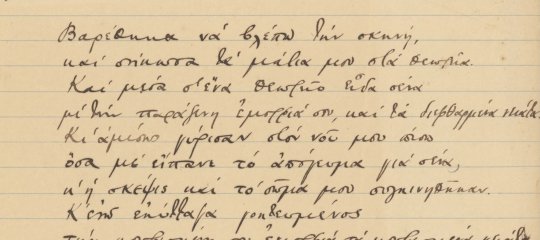Οικονομικό Παν/μιο της Σμύρνης ΙΙ (αρχάριοι)
ΟΙΚΟΝΟΜΙΚΟ ΠΑΝΕΠΙΣΤΗΜΙΟ ΤΗΣ
ΣΜΥΡΝΗΣ
GRK 101
FINALEXAM
16/01/2006
Όνομα:
Επίθετο:
|
Άσκηση |
Α |
Β |
Γ |
Δ |
Ε |
Ζ |
Η |
Θ |
Ι |
||
|
Βαθμοί |
15 |
15 |
06 |
10 |
10 |
10 |
10 |
15 |
9 |
||
|
Σύνολο |
|||||||||||
|
Βαθμοί |
100 |
||||||||||
|
Σύνολο |
/100 |
||||||||||
A. Διάβασε το κείμενο και απάντησε στις
ακόλουθες ερωτήσεις:
(2Χ5=10)
Ο Θανάσης είναι Έλληνας και είναι παντρεμένος με την
Ντολόρες. Η Ντολόρες είναι Ισπανίδα από τη Βαρκελώνη αλλά
μιλάει ελληνικά πολύ καλά. Μένουν στην Ισπανία, στη Μαδρίτη
κοντά στο κέντρο. Έχουν ένα παιδί τον Ιάσωνα. Ο Ιάσωνας
είναι δεκαέξι χρονών και πάει στο σχολείο. Μιλάει πολύ καλά
ισπανικά, αλλά δεν καταλαβαίνει πολύ καλά ελληνικά γιατί
δεν μαθαίνει στο σχολείο. Μιλάει μόνο στο σπίτι με τον
πατέρα του. Αγαπάει πολύ την Ελλάδα και το σουβλάκι.
Τώρα έχει ένα καινούργιο φίλο στην τάξη του, τον λένε
Τζον και είναι Άγγλος. Ο Τζον αγαπάει τη Μάρτα, μια
Ισπανίδα πολύ ωραία αλλά η Μάρτα δεν αγαπάει τον Τζον,
είναι ερωτευμένη με τον Ιάσωνα. Ο Ιάσωνας δεν θέλει τη
Μάρτα. Σκέφτεται την Βιρχίνια γιατί είναι ωραίο κορίτσι και
ακούει ροκ μουσική.
1. Από πού είναι η Ντολόρες;
..................................................................................................
2. Γιατί ο Ιάσωνας δεν καταλαβαίνει πολύ καλά
ελληνικά;
..................................................................................................
3. Από πού είναι ο καινούργιος φίλος του;
..................................................................................................
4. Ποια αγαπάει ο Τζον;
..................................................................................................
5. Γιατί ο Ιάσωνας δεν θέλει τη Μάρτα;
..................................................................................................
Απάντησε Σωστό ή
Λάθος:
(1X5=5)
| Σ Λ | |
| 1. Η Ντολόρες δεν μιλάει ελληνικά καθόλου. | ..... ..... |
| 2. Ο Θανάσης και η Ντολόρες μένουν στη Βαρκελώνη. | ..... ..... |
| 3. Ο Ιάσωνας δεν μαθαίνει ελληνικά στο σχολείο. | ..... ..... |
|
4. Ο Ιάσωνας αγαπάει πολύ την Ελλάδα και το ούζο. |
..... ..... |
| 5. Η Μάρτα δεν αγαπάει τον Τζον. | ..... ..... |
Β. Συμπλήρωσε τις ακόλουθες προτάσεις με
Ονομαστική ή
Αιτιατική.
(1Χ15=15)
1. O Γιάννης μιλάει με
..................................... (η Eλένη)
2. ...................................... μου θέλει
νερό. (το παιδί)
3. Η κυρία Ιωαννίδη πάει
σ....................................... (ο Καναδάς)
4. Ο Μουσταφά είναι από
................................... (η Τουρκία)
5. Η Μαρία αγαπάει
.......................................(ο Γιώργος)
6. Θέλω
.................................................................
(ο ακριβός αναπτήρας)
7. Ξέρετε
.................................................................μας;
(η καινούργια καθηγήτρια)
8. ............................................ μιλάει
πολύ καλά αγγλικά. (η κυρία)
9. Σου αρέσει αυτό
.................................................................;
(το παλιό
βιβλίο)
10. Εμείς έχουμε
................................................... (η
ακριβή τηλεόραση)
11. Δουλεύετε με
.................................................................; (αυτός ο
κύριος)
12.
.................................................................θέλει
να πάει στο πάρτι. (το
κορίτσι μας)
13. Μιλάει πολύ καλά
ελληνικά.................................................................
μας. (ο φίλος)
14.
................................................................. πάει
στην Πάτρα. (αυτή η
κυρία)
15. Ο Χρήστος μένει με
.................................................................του. (η
μητέρα)
Γ. Βάλτε τα επίθετα στην κατάλληλη φράση:
(1X6=6)
|
άσχημος |
ωραία |
μικρό |
καινούργιος |
φτηνή |
παλιό |
1. Η Κατερίνα είναι πολύ ......................
2. Αυτή η ζώνη είναι ......................
3. Ο Κώστας δεν είναι......................
4. Το παιδί τους είναι πολύ
.........................
5. Αυτό το άγαλμα είναι πολύ
..........................
6. Αυτός ο υπολογιστής είναι
.............................
Δ. Γράψε δέκα (10) φράσεις για την οικογένεια
Σιμψωνίδη: (1Χ10=10)
"graphics/finalgrk101_files/image006.gif">
1.
"graphics/finalgrk101_files/image008.jpg">. Η Μαργαρίτα
...................................................................................
2.
"graphics/finalgrk101_files/image009.jpg">. Η Μάχη
...................................................................................
3.
"graphics/finalgrk101_files/image010.gif">Ο
Όμηρος.....................................................................................
4.
"graphics/finalgrk101_files/image011.gif">Ο
Μπάμπης.....................................................................................
5.
"graphics/finalgrk101_files/image012.jpg"> Ο
Όμηρος...................................................................................
6.
"graphics/finalgrk101_files/image013.jpg"> Η
Λίζα...................................................................................
7.
"graphics/finalgrk101_files/image014.jpg"> Η
Μαργαρίτα.....................................................................................
8.
"graphics/finalgrk101_files/image015.jpg"> Η Μάχη
....................................................................................
9.
"graphics/finalgrk101_files/image016.gif"> Η Λίζα
....................................................................................
10.
"graphics/finalgrk101_files/image017.gif"> Ο
Μπάμπης...................................................................................
Ε. Συμπληρώστε την ακόλουθο παράγραφο με τα γράμματα
που λείπουν:
(20Χ 0.5=10 )
Ο Δημήτρης είναι από τ__ν Κρήτη αλλά μέν__
στην Αθ__να.
Είναι δάσκαλ__ς. Είναι παντρεμ__νος με την Ελένη κ__
μ__νουνε στην οδ__ Θεωρίας στο κέντρ__. Η Ελέν__ δουλεύ__
στον μανάβ__. Κι εγ__ είμαι από την Κρήτη, αλλά μ__νω
στ__ν Αθήν__. Με λενε Μαρ__α, είμ__ ελεύθερ__
και δεν δουλεύ__ .
Ζ. Βάλε την σωστή αντωνυμία στην κάθε πρόταση:
(1Χ10=10)
|
Που, πόσο, τι, πώς, ποιος, πόσω, ποια, ποιο |
1. ............ κάνει αυτή η καρέκλα;
2. ............μένει η Όγκε;
3. ............ κάνει ο πατέρας σου;
4 ............χρονών είναι ο Αλέκος;
5. ............ είναι η κόρη του;
6. ............δουλεύει ο αδελφός της;
7. ............είναι το βιβλίο μου;
8. ............λένε την αδερφή του;
9. ............σημαίνει μπράδερ στα αγγλικά;
10............ έχει ένα πακέτο τσιγάρα στην Τουρκία;
Η. Βρες την
εθνικότητα:
(1Χ10=10)
1. Η Μόνικα Μπελούτσι είναι Ι.........................
από την Ρώμη.
2. Ο Τσου είναι από το Πεκίνο, είναι
Κ........................
3. Ο Πολ είναι Ά........................ από το
Λονδίνο
4. Ο Χανς είναι Γ.............................. και
μιλάει γερμανικά.
5. Η Δανάη είναι Ε...........................και ο
Χρηστός είναι Ε................... από την Αθήνα.
6. Ο Ροναλντίνιο είναι
Β.................................... από το Πόρτο
Αλέγκρο.
7. Ο Μουράτ είναι Τ.......................... και η
Αισέ είναι Τ.................... από την Σμύρνη.
8. Η Τατιάνα είναι Ρ...................................
από τη Μόσχα.
Θ. Βάλε τα ρήματα στο σωστό πρόσωπο:
(1Χ15=15)
1. Τι ............ Αλέξη, καλά είσαι; (γίνομαι)
2. Εμείς ............ πολύ τα παιδιά. (αγαπάω)
3. ο Νίκος ............ στο σχολείο; (πάω)
4. Τι ............αυτοί ; (τρώω)
5. Κύριε Χριστοδούλου τι ............; (σκέφτομαι)
6. Εγώ και η Νάντια ............ κλασική μουσική.
(ακούω)
7. Αυτοί ............ από τη δουλειά τώρα. (έρχομαι)
8. Τι ............! Ο γιος σου είναι παντρεμένος; (λέω)
9. Που ............ Μαρίνα; (πάω)
10. Η Σοφία ............ ποια είναι η διεύθυνσή σου;
(ρωτάω)
11. Αυτός τι ............ , το μεγάλο αυτοκίνητο ή το μικρό;
(θέλω)
12. Η κυρία Παπακώστα δεν ............ αγγλικά καθόλου.
(μιλάει)
13. Εγώ δεν ............ κοκορέτσι. (τρώω)
14. Γιατί δεν ............την καθηγήτριά σου; (ακούω)
15. Ο κύριος Ιωάννου δεν ............ στο σπίτι μας.
(έρχομαι)
I. Γράψε κάτω από κάθε εικόνα την αντίστοιχη
λέξη και άρθρο:
(1.5X6=9)
"graphics/finalgrk101_files/image019.jpg" align="left" hspace="12"> |
"graphics/finalgrk101_files/image021.jpg" align="left" hspace="12"> |
"graphics/finalgrk101_files/image023.jpg" align="left" hspace="12"> |
| 1. ..... ..................... | 2. ..... ..................... | 3. ..... ..................... |
"graphics/finalgrk101_files/image025.jpg" align="left" hspace="12"> |
"graphics/finalgrk101_files/image027.jpg" align="left" hspace="12"> |
"graphics/finalgrk101_files/image029.jpg" align="left" hspace="12"> |
| 4. ..... ..................... | 5. ..... ..................... | 6. ..... ..................... |










